1240
Mysterious discovery, the origin of which is still unknown (17 photos)
Archaeologists have dug out of the ground a lot of items, most of which are fairly simple - arrowheads, or pots. But there are those who make the experts scratching their heads, because they understand that it is very difficult. And what was done and by whom - and even more so.
1. Middle East following

Surely you know about the Nazca lines in Peru - ancient geoglyphs, visible only from a bird's flight into known except that they are inferior to the Egyptian pyramids. But in the Middle East also have the geoglyphs, though less well known, but even more mysterious and ancient.

These "wheels" are circular stone constructions in the desert of Syria and Saudi Arabia. It is believed that they were at least 2,000 years, but no one knew about it until 1920, ie until the aircraft. Archaeologists report that need to rise by at least 30 meters above the ground to see the circles.
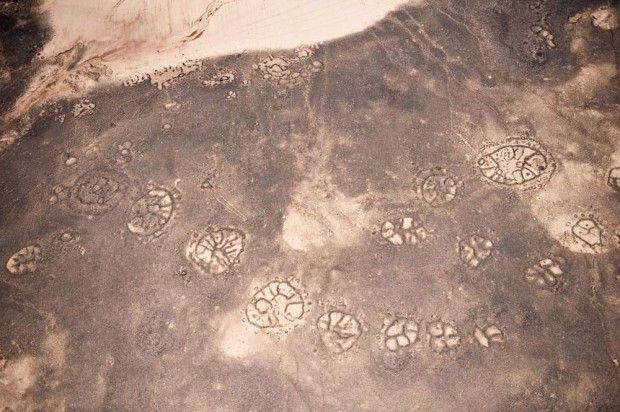
What are they and what are they - is not yet clear. Some circles are grouped, others - no. One circle is a kind of "spokes", which correspond to astronomical phenomena in other "spokes" are traced if at random. Circles may be remnants of buildings or cemeteries, but most scholars are inclined to think that they had a religious significance.
2. Wall-Mount
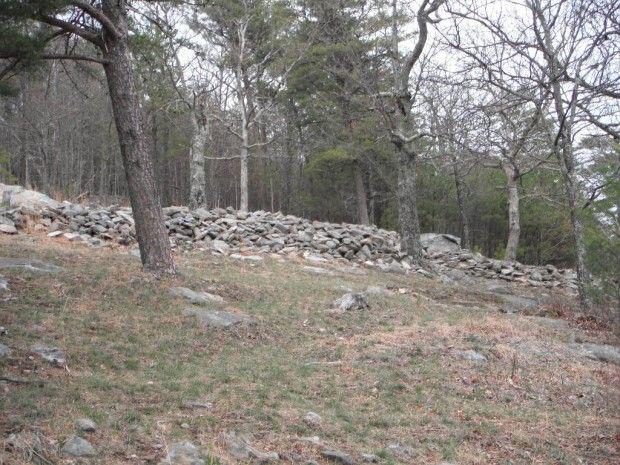
In the US state of Georgia tour guides usually say something like: "Now we come to the mysterious prehistoric wall." Yes, it is. Who built the wall, I do not know why - too.
The wall is 270 meters long and two meters in height, at least in some places. The entire length of the wall can be found 30 pits, and in one place there are the remnants of the gate. The wall was built about 1,600 years ago, although the hole may have dug much later European treasure hunters.
There is a theory that the wall mount protected from attacks, but it seems unlikely. Source of water in these areas is not, in some places the wall is too low, and it is not built on the slopes, which can be considered of strategic importance. Other theories suggest that the wall used to worship the sun or even abroad, "recreation" for the newlyweds on their honeymoon.

Zig-zag shape of the wall is similar to the patterns found in the Indian ceramics. This form may correspond to the motion of celestial bodies, and the north end of the wall indicates the place of the sun during the summer solstice.
Cherokee Legends say that the builders of the walls were underground inhabitants - tall, light-skinned, bearded, waking at night and "lunookie." Perhaps we are talking about previously lived on this earth hitchiti tribes - they had beards and lived in a cave-like underground structures. If they were high and loved astronomy, the explanation seems quite logical.
3. Cross Derek Mahoney from Glastonbury

Arthurian legends, there are many. One of them is this: in 1191, the year the monks of Glastonbury Abbey discovered his coffin. Nearby was the cross on which were engraved the words: «HIC IACET SEPULTUS INCLITUS REX ARTHURIUS IN INSULA AVALONIA», which translates as: "Here sleeps the eternal sleep great King Arthur on the island of Avalon».
Many believe that if there was a cross, the monks did it themselves to them in the abbey comes more pilgrims. Nevertheless, the historical deception XII-th century is very valuable. The last entry of the cross appeared in the XVII-th century, and experts would very much like to know more about the mysterious cross. And in December 1981, the British Museum was a man who claimed that he found the cross.
Unfortunately, Derek Mahoney refused to hand over the cross museum staff, or even allow it to inspect. Then, the museum turned to the authorities, who owned the land where Mahoney allegedly found the artifact, and the Council has received a court order for the removal of the cross. But Mahoney still refused to say where he is. In April 1982, the judge sentenced Mahoney to two years in prison, but said that he was released, as soon as he finally says, where cross.
In January 1983, a lawyer for other purposes (such lawyers in England is generally given to people unable to defend themselves on their own) asked the court to apply for exemption Mahoney. But Mahoney, oddly enough, claimed that he should remain in prison, as a lawyer intended better to go somewhere else and get to work. History repeated itself when the High Court ordered the release of the country's Mahoney. Despite the fact that Mahoney countered from prison he literally kicked.
Later it turned out that Mahoney was mold for lead and the necessary skills to make a fake cross. But even if he did it well enough to fool experts and convince the authorities that he was right, it would still put in jail for such deception. But it is believed that Mahoney really know where to cross. That's just one ancient relic never saw.
4. Unicorn Tapestries

The Cluny Museum in Paris kept six beautiful tapestries depicting the hunt for a unicorn. Who created them - is unknown. They were made in the XV-th and XVI-th century, but until 1814 there was no mention of them. No one even knew of their existence until 1841, the year of the tapestry, wet and podedennye mice did not learn from home Chateau de Boussac.

At least something about the history of tapestries might say Monogram «AE» and «AF», embroidered in each corner ... if at least someone understood what they meant. In five of the six tapestries depicts a slim blonde woman, but about who she is, too, one can only guess.
Many historians believe that it was Henry VIII's sister Mary Tudor, who was married to King Louis XII of France in the last six months of his life. Many see trellis allusions to marriage, love and the desire to have children.

Others believe that the scene on the trellis represent the five senses. In the first trellis woman touching the unicorn, the second feeds the birds, smelling a flower on the third, fourth at playing a musical instrument, and finally, the fifth indicates the unicorn at his reflection. Christian Scientists believe that a unicorn - it is the image of Christ, and the woman - his mother Mary. And there are those who believe that depict hunting scenes of the unicorn.
5. Skull Peruvians in Florida
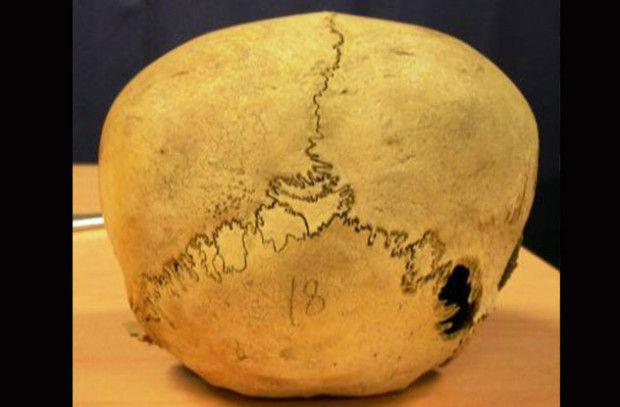
In January of 2012, during the excavation pit for a swimming pool in South Florida have found the skull of a boy and an adult male. Small skull belonged to a ten-year child, and on the bones still remained tissue.
The police were called - it could be the next murder. But no: the mummified body of the skull, and the two skulls was at least 800 years, even more strange was the fact that the skull had a unique structure, known as the Inca bone, which is characterized mainly for Peruvians.
Near the skulls were other primitive artifacts - remains of clothes and a sling. They may, in 1930, bought and brought here by tourists before the laws prohibit the sale of such artifacts. The same applies to the skull - perhaps they planted Florida migrants from Peru. In any case, to understand how the ancient Peruvians skull appeared on someone's backyard, it is no longer possible.
6. Glozelianskie table

In 1924, the year the farmer Emile Fradin found at one of its fields full of strange objects underground chamber. It contained human bones, hermaphrodite idols, masks and several tablets engraved with inscriptions in a strange language. Fradin called archaeologists, and for many years on this site were excavated. During this time, thousands of artifacts have been found.
At the opening of the debate conducted so that the «New-York Times» in 1927 called them "Glozelianskoy war" meant that the whole of France was divided into two camps, each of whom defended his opinion.
Because of that argument? No one knew for sure whether authentic artifacts. Some archaeologists argue that the tables were made during the Neolithic period, and the language - a precursor of the Phoenician alphabet, from which the Greek, Hebrew, Latin, Arabic and Cyrillic alphabets. If this is true, then the cradle of civilization - France, not the Middle East.
It got to the court: Fradin filed a lawsuit against the head of the Louvre for libel. Then the police conducted a search in the house of a farmer and apparently found some recently cut plates. Farmer arrested for fraud, but supporters Fradin of forgery not believe. International experts in their reports called all found signs fakes, but it only sparked controversy. Fradin and not condemned.
Modern tests show that the bones at this point collected from many different eras - some bones lie with the 300's in Godot. BC. e., the other - from the XVII-th century. Glass was made in France in the Middle Ages. But signs seem peers oldest bones - they just do not less than 2000 years. The clay from which they are made chemically identical to a local clay, so that made them, probably in France. Most experts agree that the language on the plates - one of the varieties starokeltskogo language. It seems that there is no mystery.
But it is unclear how much of unusual and varied objects appeared in one place - the second such no place in Europe. The only one who could at least know something, Fradin, it never made it clear - in 2010, the year he died and took away the secret to the grave. If you knew, of course.
7. Mysterious stone

In 1872 during the construction of the basement near Lake Winnipesaukee in New Hampshire, USA, the builders discovered a strange object - it was a black stone egg with carved images of about ten centimeters tall. He immediately recognized the scientific miracle of the world: never before in the United States did not find anything like this and still have not found. The find is known as a mysterious stone.
Front (call it so for want of a better designation for the eggs) to egg engraved face. On each side - corn on the cob, circles, parts of animals, spiral, crescent and various lines and points. The top and bottom there are numerous holes, presumably by using technologies XIX-th century, and it means that the stone was made shortly before he was found.
No details recorded. The exact location and depth at which lay the stone, is unknown. The rocks of the type that comprises a stone in New Hampshire there. After nearly 150 years of research, scientists still do not know who did it, and why the stone was in the ground.
8. Golden hats
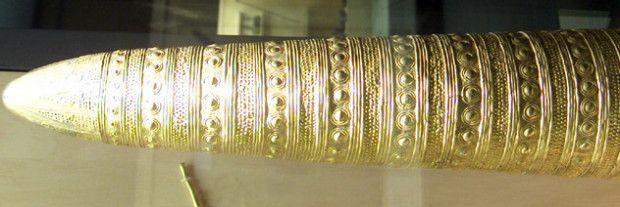
Perhaps the most unusual artifacts of the Bronze Age in Europe can be called four gold caps or cones. Their height varies from 30 cm to almost one meter. Caps 90% are made of gold and decorated with extremely complex concentric circles. The oldest known caps - Berlin cone: it was created about 1300 year BC. e., and discovered in 1835. In 1739 cone engraved symbols of the Sun and the Moon.
Presumably the cones could be parts of the armor, ceremonial vases, ornaments religious sites, or even hats "wizards", or rather, the priests-astronomers. Modern analysis shows that the cones are shown accurate solar and lunar cycles, which are the first to observe the astronomer Meton of Athens in the V-th century BC. e. This may mean that protokeltskaya culture for several centuries ahead of his time.
9. Egyptian spiders
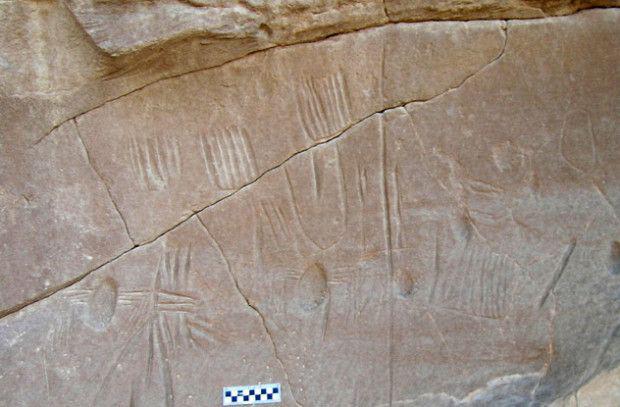
In 2013, archaeologists discovered in Egypt a stone panel with engravings, which may be the earliest known image of spiders in the world. Panels, probably about 6,000 years old, making it older than the ancient Egyptian civilization.
There are assumptions that the spiders depicted here - a "blank." It seems to be true: an oval with four slender curved "legs" look like spiders on the children's drawings. Similar images can be stars of cobwebs.
Dr. Heather Lynn, author and proponent of "alternative archeology", said that in fact represented on the panel do not spiders, and Sirius star system. This is supposedly old map of the starry sky - the ancient people definitely enjoyed looking up. In addition, there is plenty of evidence that the ancient Egyptians were interested in astronomy, but about their interest in spiders is not known.
10. Aram Moore

The gates of the Incas in Peru Aram Moore - a huge "notch" in the solid rock: a flat plate with the two sides framed depression seven meters tall. In the center of the plate there is another recess, the height and width of about person. A feeling that someone started carving in the rock building or something like that, and then threw.

This "door" Amateur Paranormal - almost a cult object: they consider it a magic portal. Locals consider it the gateway to the underworld, which is using a special key or spell can open wizards. Some say that the "door" is opened at midnight, and on the other side is the town. There is even a theory that the "gates" lead to the other end of the universe.

Perhaps the natives thousands of years ago actually discovered a way to travel among the stars? It would be great if it was true that theory. But, most of all, someone just had to quit building, that you will agree, a little sad.
1. Middle East following

Surely you know about the Nazca lines in Peru - ancient geoglyphs, visible only from a bird's flight into known except that they are inferior to the Egyptian pyramids. But in the Middle East also have the geoglyphs, though less well known, but even more mysterious and ancient.

These "wheels" are circular stone constructions in the desert of Syria and Saudi Arabia. It is believed that they were at least 2,000 years, but no one knew about it until 1920, ie until the aircraft. Archaeologists report that need to rise by at least 30 meters above the ground to see the circles.

What are they and what are they - is not yet clear. Some circles are grouped, others - no. One circle is a kind of "spokes", which correspond to astronomical phenomena in other "spokes" are traced if at random. Circles may be remnants of buildings or cemeteries, but most scholars are inclined to think that they had a religious significance.
2. Wall-Mount

In the US state of Georgia tour guides usually say something like: "Now we come to the mysterious prehistoric wall." Yes, it is. Who built the wall, I do not know why - too.
The wall is 270 meters long and two meters in height, at least in some places. The entire length of the wall can be found 30 pits, and in one place there are the remnants of the gate. The wall was built about 1,600 years ago, although the hole may have dug much later European treasure hunters.
There is a theory that the wall mount protected from attacks, but it seems unlikely. Source of water in these areas is not, in some places the wall is too low, and it is not built on the slopes, which can be considered of strategic importance. Other theories suggest that the wall used to worship the sun or even abroad, "recreation" for the newlyweds on their honeymoon.

Zig-zag shape of the wall is similar to the patterns found in the Indian ceramics. This form may correspond to the motion of celestial bodies, and the north end of the wall indicates the place of the sun during the summer solstice.
Cherokee Legends say that the builders of the walls were underground inhabitants - tall, light-skinned, bearded, waking at night and "lunookie." Perhaps we are talking about previously lived on this earth hitchiti tribes - they had beards and lived in a cave-like underground structures. If they were high and loved astronomy, the explanation seems quite logical.
3. Cross Derek Mahoney from Glastonbury

Arthurian legends, there are many. One of them is this: in 1191, the year the monks of Glastonbury Abbey discovered his coffin. Nearby was the cross on which were engraved the words: «HIC IACET SEPULTUS INCLITUS REX ARTHURIUS IN INSULA AVALONIA», which translates as: "Here sleeps the eternal sleep great King Arthur on the island of Avalon».
Many believe that if there was a cross, the monks did it themselves to them in the abbey comes more pilgrims. Nevertheless, the historical deception XII-th century is very valuable. The last entry of the cross appeared in the XVII-th century, and experts would very much like to know more about the mysterious cross. And in December 1981, the British Museum was a man who claimed that he found the cross.
Unfortunately, Derek Mahoney refused to hand over the cross museum staff, or even allow it to inspect. Then, the museum turned to the authorities, who owned the land where Mahoney allegedly found the artifact, and the Council has received a court order for the removal of the cross. But Mahoney still refused to say where he is. In April 1982, the judge sentenced Mahoney to two years in prison, but said that he was released, as soon as he finally says, where cross.
In January 1983, a lawyer for other purposes (such lawyers in England is generally given to people unable to defend themselves on their own) asked the court to apply for exemption Mahoney. But Mahoney, oddly enough, claimed that he should remain in prison, as a lawyer intended better to go somewhere else and get to work. History repeated itself when the High Court ordered the release of the country's Mahoney. Despite the fact that Mahoney countered from prison he literally kicked.
Later it turned out that Mahoney was mold for lead and the necessary skills to make a fake cross. But even if he did it well enough to fool experts and convince the authorities that he was right, it would still put in jail for such deception. But it is believed that Mahoney really know where to cross. That's just one ancient relic never saw.
4. Unicorn Tapestries

The Cluny Museum in Paris kept six beautiful tapestries depicting the hunt for a unicorn. Who created them - is unknown. They were made in the XV-th and XVI-th century, but until 1814 there was no mention of them. No one even knew of their existence until 1841, the year of the tapestry, wet and podedennye mice did not learn from home Chateau de Boussac.

At least something about the history of tapestries might say Monogram «AE» and «AF», embroidered in each corner ... if at least someone understood what they meant. In five of the six tapestries depicts a slim blonde woman, but about who she is, too, one can only guess.
Many historians believe that it was Henry VIII's sister Mary Tudor, who was married to King Louis XII of France in the last six months of his life. Many see trellis allusions to marriage, love and the desire to have children.

Others believe that the scene on the trellis represent the five senses. In the first trellis woman touching the unicorn, the second feeds the birds, smelling a flower on the third, fourth at playing a musical instrument, and finally, the fifth indicates the unicorn at his reflection. Christian Scientists believe that a unicorn - it is the image of Christ, and the woman - his mother Mary. And there are those who believe that depict hunting scenes of the unicorn.
5. Skull Peruvians in Florida

In January of 2012, during the excavation pit for a swimming pool in South Florida have found the skull of a boy and an adult male. Small skull belonged to a ten-year child, and on the bones still remained tissue.
The police were called - it could be the next murder. But no: the mummified body of the skull, and the two skulls was at least 800 years, even more strange was the fact that the skull had a unique structure, known as the Inca bone, which is characterized mainly for Peruvians.
Near the skulls were other primitive artifacts - remains of clothes and a sling. They may, in 1930, bought and brought here by tourists before the laws prohibit the sale of such artifacts. The same applies to the skull - perhaps they planted Florida migrants from Peru. In any case, to understand how the ancient Peruvians skull appeared on someone's backyard, it is no longer possible.
6. Glozelianskie table

In 1924, the year the farmer Emile Fradin found at one of its fields full of strange objects underground chamber. It contained human bones, hermaphrodite idols, masks and several tablets engraved with inscriptions in a strange language. Fradin called archaeologists, and for many years on this site were excavated. During this time, thousands of artifacts have been found.
At the opening of the debate conducted so that the «New-York Times» in 1927 called them "Glozelianskoy war" meant that the whole of France was divided into two camps, each of whom defended his opinion.
Because of that argument? No one knew for sure whether authentic artifacts. Some archaeologists argue that the tables were made during the Neolithic period, and the language - a precursor of the Phoenician alphabet, from which the Greek, Hebrew, Latin, Arabic and Cyrillic alphabets. If this is true, then the cradle of civilization - France, not the Middle East.
It got to the court: Fradin filed a lawsuit against the head of the Louvre for libel. Then the police conducted a search in the house of a farmer and apparently found some recently cut plates. Farmer arrested for fraud, but supporters Fradin of forgery not believe. International experts in their reports called all found signs fakes, but it only sparked controversy. Fradin and not condemned.
Modern tests show that the bones at this point collected from many different eras - some bones lie with the 300's in Godot. BC. e., the other - from the XVII-th century. Glass was made in France in the Middle Ages. But signs seem peers oldest bones - they just do not less than 2000 years. The clay from which they are made chemically identical to a local clay, so that made them, probably in France. Most experts agree that the language on the plates - one of the varieties starokeltskogo language. It seems that there is no mystery.
But it is unclear how much of unusual and varied objects appeared in one place - the second such no place in Europe. The only one who could at least know something, Fradin, it never made it clear - in 2010, the year he died and took away the secret to the grave. If you knew, of course.
7. Mysterious stone

In 1872 during the construction of the basement near Lake Winnipesaukee in New Hampshire, USA, the builders discovered a strange object - it was a black stone egg with carved images of about ten centimeters tall. He immediately recognized the scientific miracle of the world: never before in the United States did not find anything like this and still have not found. The find is known as a mysterious stone.
Front (call it so for want of a better designation for the eggs) to egg engraved face. On each side - corn on the cob, circles, parts of animals, spiral, crescent and various lines and points. The top and bottom there are numerous holes, presumably by using technologies XIX-th century, and it means that the stone was made shortly before he was found.
No details recorded. The exact location and depth at which lay the stone, is unknown. The rocks of the type that comprises a stone in New Hampshire there. After nearly 150 years of research, scientists still do not know who did it, and why the stone was in the ground.
8. Golden hats

Perhaps the most unusual artifacts of the Bronze Age in Europe can be called four gold caps or cones. Their height varies from 30 cm to almost one meter. Caps 90% are made of gold and decorated with extremely complex concentric circles. The oldest known caps - Berlin cone: it was created about 1300 year BC. e., and discovered in 1835. In 1739 cone engraved symbols of the Sun and the Moon.
Presumably the cones could be parts of the armor, ceremonial vases, ornaments religious sites, or even hats "wizards", or rather, the priests-astronomers. Modern analysis shows that the cones are shown accurate solar and lunar cycles, which are the first to observe the astronomer Meton of Athens in the V-th century BC. e. This may mean that protokeltskaya culture for several centuries ahead of his time.
9. Egyptian spiders

In 2013, archaeologists discovered in Egypt a stone panel with engravings, which may be the earliest known image of spiders in the world. Panels, probably about 6,000 years old, making it older than the ancient Egyptian civilization.
There are assumptions that the spiders depicted here - a "blank." It seems to be true: an oval with four slender curved "legs" look like spiders on the children's drawings. Similar images can be stars of cobwebs.
Dr. Heather Lynn, author and proponent of "alternative archeology", said that in fact represented on the panel do not spiders, and Sirius star system. This is supposedly old map of the starry sky - the ancient people definitely enjoyed looking up. In addition, there is plenty of evidence that the ancient Egyptians were interested in astronomy, but about their interest in spiders is not known.
10. Aram Moore

The gates of the Incas in Peru Aram Moore - a huge "notch" in the solid rock: a flat plate with the two sides framed depression seven meters tall. In the center of the plate there is another recess, the height and width of about person. A feeling that someone started carving in the rock building or something like that, and then threw.

This "door" Amateur Paranormal - almost a cult object: they consider it a magic portal. Locals consider it the gateway to the underworld, which is using a special key or spell can open wizards. Some say that the "door" is opened at midnight, and on the other side is the town. There is even a theory that the "gates" lead to the other end of the universe.

Perhaps the natives thousands of years ago actually discovered a way to travel among the stars? It would be great if it was true that theory. But, most of all, someone just had to quit building, that you will agree, a little sad.























